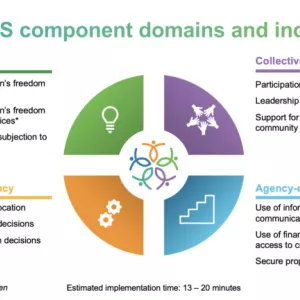Governments’ adoption of the Beijing Declaration and Platform for Action in 1995—which advanced a set of common principles on gender equality—elevated women’s empowerment in policy as an end in itself, not just as a means to achieving other development outcomes. While great strides have been made in developing tools to track progress toward gender equality since then, nationally representative and multi-topic surveys still often lack concise yet comprehensive measures of empowerment. The Women’s Empowerment Metric for National Statistical Systems (WEMNS) was developed by IFPRI and partners as a solution to this data gap.
WEMNS is a streamlined tool intended for use in large-scale, multitopic surveys in both rural and urban areas and was designed to be added to existing surveys. Unlike previous metrics, WEMNS was designed to be relevant across a wide range of livelihood strategies and only takes 15 minutes to implement. Using a similar methodology as multidimensional poverty indexes, the tool has 12 indicators spread across four domains that can be used to calculate an overall index score or broken down by indicator, allowing for comparisons across sub-populations.


